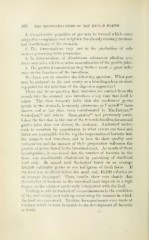Page 330 - My FlipBook
P. 330
302 THE MICRO-ORGANISMS OF THE HUMAN MOUTH.
2. Considerable quantities of gas may be formed which cause
subjective complaints and heighten the already existing mechan-
ical insufficiency of the stomach.
3. The fermentations may lead to the production of sub-
stances possessing toxic properties.
4. In fermentations of albuminous substances alkaline pro-
ducts may arise which octasion neutralization of the gastric juice.
5. The gastric fermentations may further exert a great influ-
ence on the functions of the intestines.
We have now to consider the following question : What part
may be assigned to the oral cavity as a breeding-place or start-
ing-point for the infection of the digestive apparatus ?
There can be no question that microbes are carried from the
mouth into the stomach and intestines every time that food is
taken. The view formerly held, that the swallowed germs
perish in the stomach, is entirely erroneous, as I myself™ have
shown, and as has since been corroborated by MacFadyan,^^
Sucksdorf,--" and others. Baumgarten^^ had previously estab-
lished the fact that in the case of the tubercle-bacillus the normal
gastric juice does not destroy its virulence. Sucksdorf under-
took to ascertain by experiments to what extent our food and
drink are responsible for the regular importation of bacteria into
the stomach and intestines, and in how far their quality and
composition and the manner of their preparation influence the
growth of germs found in the intestinal tract. As result of these
investigations, it was found that the number of bacteria in the
faeces was considerably diminished by partaking of sterilized
food only. In mixed food Sucksdorf found on an average
380,000 cultivable germs in one milligram of fresh fseces. If
the food was sterilized before the meal, only 10,390 colonies on
an average developed. These results show very clearly that
the number of bacteria in the intestinal tract depends in a high
degree on the number continually reimported with the food.
Xothing is said in Sucksdorf 's experiments as to the condition
of the^ oral cavity, and nothing concerning the manner in which
the food was preserved. Besides, the experiments were made at
a season which is most favorable to the development of bacteria
in foods.


